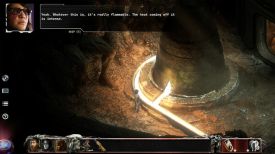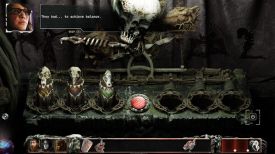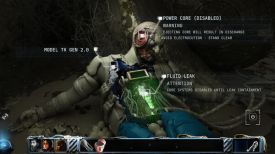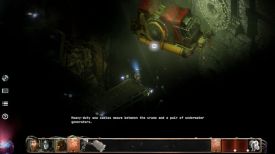STASIS: BONE TOTEM
The Brotherhood
Regular readers will be aware that I am a fan of the first STASIS game,
as well as its free adjunct CAYNE. It had its foibles and it wasn’t
perfect, but it was a lot of grisly adventuring fun. I can pretty much
say the same thing about this next iteration.
Regular readers will also know that after the last game I reviewed I
said I wanted to play something more complicated. As the saying goes “be
careful what you wish for.”
You play Mac and Charlie, a husband and wife salvage team scouring the
unfriendly oceans of the 22nd century in the hope of finding
derelict vessels or even just floating scrap. A radar ‘ping’ in the
middle of nowhere brings them alongside the DEAPSEA 15, an oil rig
belonging to the megalith Cayne Corporation. Needless to say, they
set-out to investigate their discovery.
You start as Mac, but very quickly Charlie becomes the playable
character. From that point on you can pretty much switch between them at
will, although there will be times when you are locked out of one or the
other. On a couple of occasions, they will be together, but the
developing story pushes them into separate paths, each exploring and
doing different things. Looking back, whilst their particular
circumstances largely keep them apart (i.e., they couldn’t meet up even
if they wanted to), there might well be areas where you could bring them
together, but they are doing what they are doing for a reason, so avoid
the temptation if that possibility arises.
They do however stay in communication, can see what each other sees, and
even more niftily they share an inventory. Or rather, they can both
access the same Quantum Storage Device (QSD), which creates a pocket of
interdimensional space-time. Which means they can share inventory items.
Which comes in incredibly handy, once you become comfortable with how it
works. You have to transfer items as opposed to just having them all
available to both of them, and you can do that in one of two ways which
I won’t try and explain. What I can say though is that what at first
seems a little fiddly becomes second nature and makes good
interdimensional sense.
Given the separateness of their endeavours, transferring items doesn’t
really reduce backtracking but it does mean that if e.g., Mac has found
a battery charger and Charlie has a dead battery, Mac can charge it for
her, which adds an element to the conundrums without needing for lots of
traipsing. Mac and Charlie also have different skills, a tad gender
stereotypical (Mac has strength, Charlie has engineering smarts); but
leaving that aside it means Charlie can combine items and Mac can pull
them apart or destroy them. Again there is a teeny learning curve
involved, but again it becomes second nature. Need to repair an
air-hose? Give Charlie the relevant material and let her have at it.
Want to pulverise a particular item? Mac is your man.
Then we have Moses, a ‘Toy’ Bear more Eeyore than Pooh as far as
personality is concerned but with excellent hacking skills. Fairly early
on he becomes a third playable character, and his diminutive size means
he can squeeze into places the others can’t. He also tends to be in
places away from Mac and Charlie, and he too can access the QSD. So add
another whole level of conundrum solution sharing.
A
number of NPC entities are also present, each of whom has things to say
when it suits them and the narrative. And then there is Hope. More
present in her absence, you can discover more about her for yourself.
Switching characters is as easy as choosing their image in the interface
ribbon at the bottom of the screen. Which is good, because you will do
it a lot. Often it will be because it is necessary for solving a
conundrum, perhaps more often it will be because you are thoroughly
stuck with whichever character you are playing. What I learnt was that
patience was a virtue, although a tantrum or two made me feel better.
You will be stuck sometimes because you haven’t found the necessary
item, or haven’t understood the appropriate image, or haven’t ferreted
out the relevant information from one of the many PDAs you will find.
But sometimes you will be stuck because you are meant to be, the puzzle
requiring you to take what you know and then apply it to someone and
somewhere else and then bring the outcome back. A simple example might
be a key card, which clearly activates that system you are accessing but
which then needs to have its security access upgraded which will require
you to engage the efforts of others to work out how, and then to give it
back. A character might also be e.g., trying to decipher a log-in code,
while another can find the noticeboard which displays the necessary
clue. I particularly liked these situations.
This is not an easy game, and I have to confess I was lost in terms of
what to do next on numerous occasions. Codes for doors, mixing solutions
and the like aren’t in themselves overly difficult. It was finding all
the bits needed – information and items – that presented the ongoing
challenge, as well as working out what to use where. There were
certainly times I wondered why on earth would I use that, as well as
some ‘duh’ moments and a few “I still don’t understand.” However there
were so many that for every conundrum that stumped me there were plenty
that did not.
There were also one or two out and out dud puzzles, the unnecessary maze
at the end chief among them. But one or two in a game this big (and dud
has a personal element) is probably to be expected.
If
stuck there are a range of ways to possibly move on. Having each
character examine the various inventory items might elicit a useful
response – Mac and Charlie really, as showing Moses will more likely
produce a wry bit of Moses-ness - and an in-game hint system might kick
in if you have accessed a puzzle a certain number of times. The more
difficult the puzzle the less accesses might be required, although not
every puzzle has a hint.
I
spent a fair bit of time doing that, as well looking over the copious
notes and diagrams I made from the things I read and saw. The contents
of PDAs will stay with you, so these are easily reviewed, and they
contain a lot of information. Most will be back story but not all; there
are some critical morsels tucked away in there.
None of which always elicited a way forward, which would then send me to
the excellent game guide which is available (should you choose to
purchase it). Use it as you see fit, being mindful it is essentially a
walkthrough, but just knowing e.g., which character I should now be
accessing at times provided the incentive to try harder and eventually
lead to what was needed to move on. I also found that just because you
knew you had to e.g., pull something apart, didn’t necessarily mean that
where to use the pieces was obvious, but it gave you two new
possibilities to explore.
(I
found out afterwards that there is also apparently a hint sheet in the
game installation folder, but I couldn’t find it).
Another thing you can do to help is to ping the environment at any time.
This will generate an array of blue and green lines emanating from a
gizmo on your wrist, each leading to, or pointing towards, different
types of hotspots. The directional lines remain on screen for a while
and then disappear, but just ping again if you want them back.
The green lines are about detail, and hovering the mouse over the end
point will generate a description of whatever it is at that particular
hotspot. Read them or ignore them; its up to you. Many are written as
you would describe things in a book, and while it is occasionally a bit
florid, to me it added to the overall narrative experience, and is far
more interesting than a bland label.
The blue ones are far more critical. Each blue hotspot is something you
can (probably) interact with in some way, so ignore them at your peril.
The endpoint of the line might not be in your current field of view
(screens can scroll sideways and up and down so you might need to move
about to reach the endpoint), but if you can see the end, moving your
mouse to the hotspot will usually tell you what it is – a terminal or a
microscope or a control panel perhaps, or just something at which you
can ‘take a look.’ If there is no information, it will (exclusively I
believe) be an exit point from the current screen.
What is a small blue circle at the hotspot will become a larger white
one if you draw close and can interact with it, or a lager blue
‘turnstile arrow’ if its an exit.
A
ping can also indicate the relevant hotspot/s within a puzzle or a
close-up inspection, which can be useful. Objects you can take from
e.g., that pile of dead bodies, will have a shimmer about them, but if
you have to e.g., extract fluid from one of the corpses, it may not be
apparent from whereabouts you need to do that. A ping will assist you.
While on one level a ping is the equivalent of ‘show all hotspots,’ I
liked that the action was relevantly embedded into the game. The blue
lines also serve another useful purpose but more of that shortly.
You can of course forsake the pinging and find hotspots by sweeping the
mouse about the environment and exploring carefully. The active area to
generate the hotspot is fairly generous, and it will become visible when
the mouse gets close. You might also activate a hotspot if a character
passes close by, on their way to somewhere else perhaps. Ping or don’t
ping, or ping sometimes, its up to you. While I was resistant to use it
all at the beginning, and then vacillated back and forth, I probably
tended towards using the ping more often than I didn’t.
Which brings us to the other benefit of pinging.
This is a dark game, both in terms of its story and the environment. The
Cayne Corporation is a shadowy entity to say the least, and engaging in
iffy and horrific things is their stock in trade. So why wouldn’t you
conduct it in the middle of nowhere, associated with something more
mundane. Quite apart from that, a derelict oil rig is not a well-lit
place, nor is the seabed and the facility you will find yourself in.
Even getting the power back on doesn’t light things up like a Christmas
tree, so you will spend a fair bit of time not being able to see
everything in the larger environment around you. Your immediate field of
vision will be fine, and lights flash, fires burn and luminescence
glows, so its not all gloom, but there are times when you may well
wonder “where on earth do I/can I go and how might I get there.”
A
ping will help. Whether you can see the end point of the directional
line or not, there is clearly something over there. Click in the
vicinity and off the character will go. As they make their way there,
you will get a much better sense of how this particular part of the
environment is constructed, and you might uncover stuff as you go.
The story is an involved one, seemingly simple but then not. I already
mentioned that it was dark, and it quickly has a somewhat unhinged
Lovecraft tone. A degree of the devil is in the detail, and reading
everything you find will contribute. The bugs/other beings/evil
experiments from the earlier incarnation are back (Cayne is awful, if
you needed reminding), as are unholy alliances. Some stuff I thought I
saw coming, several twists not at all.
There is though humour, and courage and warmth, sometimes rather
surprisingly. And a post credit sting so keep watching.
This is already too long so let me be relatively brief in finishing.
It
is all point and click and you can save at will. The sound, the score
and particularly the voice acting of Mac and Charlie are excellent.
Moses impressed me with his mix of devotion and wry self-preservation.
Visually it is sumptuous, and the awfulness of things is writ large.
There are some wonderfully nightmarish sequences and cutscenes are
cinematic and impressive. A character death (you just get to try again)
is accompanied by a suitable burst of blood spatter. Click bottom left
to pull up the interface, including the PDA. When a character is talking
you get a headshot top left. Double click to run. The narrative meanders
a bit at times but it’s a rich and fantastical affair. It is also long,
15-20 hours seeming to be the norm, but can easily be longer. The top-ish
down 2D isometric view works a treat, as does the fact that not every
scene fills the screen, accentuating the crushing darkness and almost
claustrophobic nature of things. The earlier inspirations of things like
Alien and Sanitarium resonate again, and there is a visceral Cronenberg-feel
about the whole thing. Between the body parts, the ‘bugs’ and the detail
in the ‘readings’ (if you read it all there is a lot), it’s a grisly,
sometimes gory bit of gleefully gruesome adventuring.
Which was perhaps too brief so let me say a little bit more.
This is a challenging game and is best enjoyed by being willing to
invest time and effort and that patience I mentioned previously into the
endeavour. Is there not enough direction, is it too dark sometimes to
see properly, are too many clues too easy to miss? You could well answer
yes to all of these. But the game world completely sucked me in, and
made me want to wander and explore and almost just hang out. So I did
all those things I mentioned, and then perhaps went off and just checked
out some of the green detail, or screamed into the void, or admired the
grandness of this structure or that horrific offering. All the while
knowing help was ultimately not far away.
I
had a ball.
I played on:
OS: Windows
10, 64 Bit
Processor:
Intel i7-9700K 3.7GHz
RAM: Corsair
Dominator Platinum RGB DDR4 32GB
Video card:
AMD Radeon RX 580 8192MB
GameBoomers Review Guidelines
June 2017
design copyright© 2017
GameBoomers
Group






